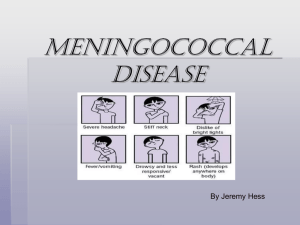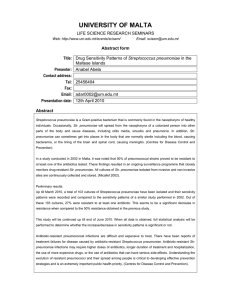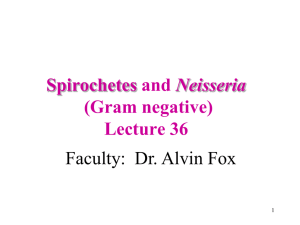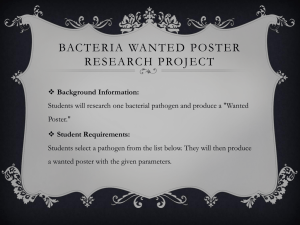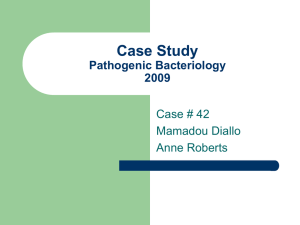Document 13308604
advertisement
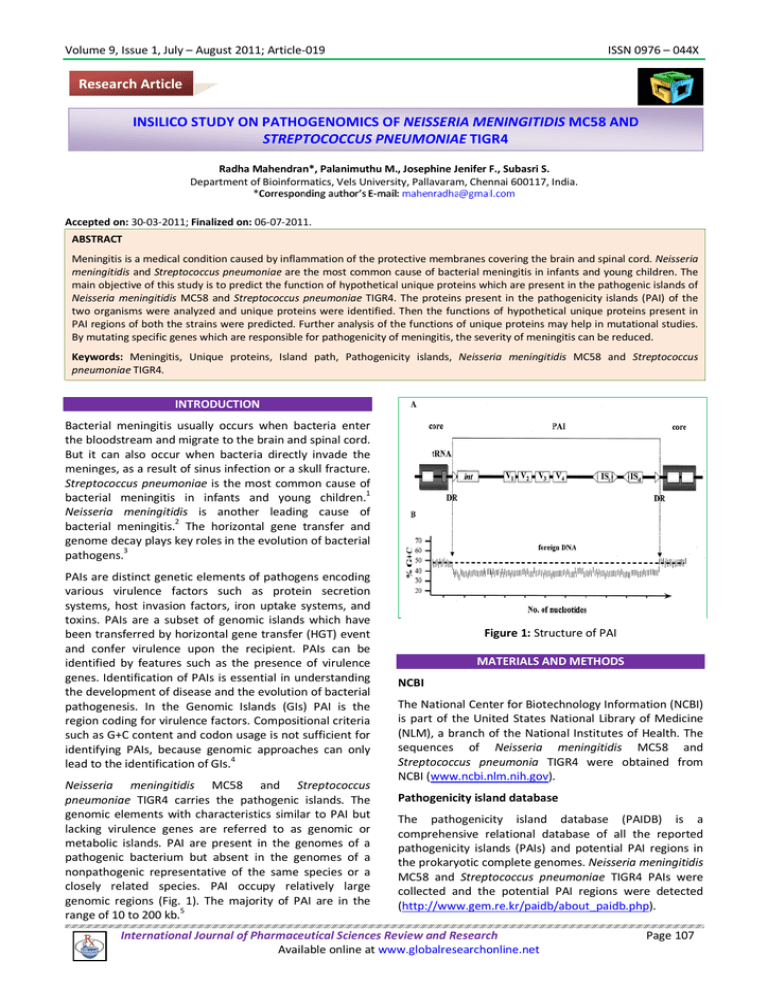
Volume 9, Issue 1, July – August 2011; Article-019 ISSN 0976 – 044X Research Article INSILICO STUDY ON PATHOGENOMICS OF NEISSERIA MENINGITIDIS MC58 AND STREPTOCOCCUS PNEUMONIAE TIGR4 Radha Mahendran*, Palanimuthu M., Josephine Jenifer F., Subasri S. Department of Bioinformatics, Vels University, Pallavaram, Chennai 600117, India. Accepted on: 30-03-2011; Finalized on: 06-07-2011. ABSTRACT Meningitis is a medical condition caused by inflammation of the protective membranes covering the brain and spinal cord. Neisseria meningitidis and Streptococcus pneumoniae are the most common cause of bacterial meningitis in infants and young children. The main objective of this study is to predict the function of hypothetical unique proteins which are present in the pathogenic islands of Neisseria meningitidis MC58 and Streptococcus pneumoniae TIGR4. The proteins present in the pathogenicity islands (PAI) of the two organisms were analyzed and unique proteins were identified. Then the functions of hypothetical unique proteins present in PAI regions of both the strains were predicted. Further analysis of the functions of unique proteins may help in mutational studies. By mutating specific genes which are responsible for pathogenicity of meningitis, the severity of meningitis can be reduced. Keywords: Meningitis, Unique proteins, Island path, Pathogenicity islands, Neisseria meningitidis MC58 and Streptococcus pneumoniae TIGR4. INTRODUCTION Bacterial meningitis usually occurs when bacteria enter the bloodstream and migrate to the brain and spinal cord. But it can also occur when bacteria directly invade the meninges, as a result of sinus infection or a skull fracture. Streptococcus pneumoniae is the most common cause of bacterial meningitis in infants and young children.1 Neisseria meningitidis is another leading cause of bacterial meningitis.2 The horizontal gene transfer and genome decay plays key roles in the evolution of bacterial pathogens.3 PAIs are distinct genetic elements of pathogens encoding various virulence factors such as protein secretion systems, host invasion factors, iron uptake systems, and toxins. PAIs are a subset of genomic islands which have been transferred by horizontal gene transfer (HGT) event and confer virulence upon the recipient. PAIs can be identified by features such as the presence of virulence genes. Identification of PAIs is essential in understanding the development of disease and the evolution of bacterial pathogenesis. In the Genomic Islands (GIs) PAI is the region coding for virulence factors. Compositional criteria such as G+C content and codon usage is not sufficient for identifying PAIs, because genomic approaches can only 4 lead to the identification of GIs. Neisseria meningitidis MC58 and Streptococcus pneumoniae TIGR4 carries the pathogenic islands. The genomic elements with characteristics similar to PAI but lacking virulence genes are referred to as genomic or metabolic islands. PAI are present in the genomes of a pathogenic bacterium but absent in the genomes of a nonpathogenic representative of the same species or a closely related species. PAI occupy relatively large genomic regions (Fig. 1). The majority of PAI are in the range of 10 to 200 kb.5 Figure 1: Structure of PAI MATERIALS AND METHODS NCBI The National Center for Biotechnology Information (NCBI) is part of the United States National Library of Medicine (NLM), a branch of the National Institutes of Health. The sequences of Neisseria meningitidis MC58 and Streptococcus pneumonia TIGR4 were obtained from NCBI (www.ncbi.nlm.nih.gov). Pathogenicity island database The pathogenicity island database (PAIDB) is a comprehensive relational database of all the reported pathogenicity islands (PAIs) and potential PAI regions in the prokaryotic complete genomes. Neisseria meningitidis MC58 and Streptococcus pneumoniae TIGR4 PAIs were collected and the potential PAI regions were detected (http://www.gem.re.kr/paidb/about_paidb.php). International Journal of Pharmaceutical Sciences Review and Research Available online at www.globalresearchonline.net Page 107 Volume 9, Issue 1, July – August 2011; Article-019 ISSN 0976 – 044X Island path (DB) Island path is used for the identification of genomics islands, including pathogenicity islands, of potentially horizontally transferred genes. Genomic islands (GIs), including pathogenicity islands, are frequently associated with particular adaptations of microbes that are of medical, agricultural or environmental importance.6 The island path present in the PAIs region of Neisseria meningitidis MC58 and Streptococcus pneumoniae TIGR4 were identified and analyzed. StandAlone BLAST BLAST can run locally as a full executable and can be used to run homology searches against private, local databases, or downloaded copies of the NCBI databases. StandAlone BLAST executables may be found on the NCBI anonymous FTP server (ftp://ftp.ncbi.nih.gov) under /blast/executables/. The island path of Neisseria meningitidis MC58 and Streptococcus pneumoniae TIGR4 were compared using standalone blast to find out the unique genes. sequence the scores with the highest information content are marked with arrows (=>).7,8 Hypothetical unique protein functions of Neisseria meningitidis MC58 and Streptococcus pneumoniae TIGR4 were predicted using ProtFun server (www.cbs.dtu.dk/services/ProtFun/). RESULTS AND DISCUSSION Genome sequence of Neisseria meningitidis MC58 and Streptococcus pneumonie TIGR4 were retrieved. In Neisseria meningitidis MC58 (Fig. 2), two regions of PAIs were identified, namely IHT-A (Putative island of horizontally transferred DNA-A) and IHT-C (Putative island of horizontally transferred DNA-C) (Table 1). ProtFun The ProtFun 2.2 server produces ab initio predictions of protein function from sequence. For each input sequence the server predicts cellular role, enzyme class and gene ontology categories. The scores consist of two numbers. The first number is the probability score which denotes whether the entry belongs to the enzyme or non-enzyme class. The second number is the odds value which predicts the gene ontology and functional categories. For each Figure 2: Genome information of Neisseria meningitidis MC58 Table 1: Neisseria meningitidis MC58, two regions of PAIs (IHT-A & IHT-C) and Streptococcus pneumoniae TIGR4 regions of PAIs Sl. no Name Start End Size(bp) Insertion site Function Neisseria meningitidis MC58, two regions of PAIs (IHT-A & IHT-C) Genes of the serogroup b capsulation 1 IHT-A 75694 109777 34084 NMB0060/NMB0100 cluster and an adenine rrna methylase Three toxin/toxin-related homolog ; protein known to be immunogenic, 2 IHT-C 1827738 1860290 32553 NMB1746/NMB1775 one intact and three fragmented proteins previously associated with bacteriophage Streptococcus pneumoniae TIGR4 regions of PAIs 1 PPI-1 972792 1001140 28349 SP1029/SP1067 Iron uptake (piaABCD) Table 2: Unique genes of Neisseria meningitidis MC58 and Streptococcus pneumoniae TIGR4 Sl. no Query Ref_seq Neisseria meningitidis MC58 1 n6 NP_273135.1 2 n25 NP_273154.1 3 n26 NP_273155.1 4 n29 NP_273158.1 5 n54 NP_273757.1 6 n61 NP_274748.1 Streptococcus pneumoniae TIGR4 1 s7 NP_345511.1 2 s14 NP_345518.1 Description of protein capsule polysaccharide export outer membrane protein hypothetical protein NMB0093 hypothetical protein NMB0094 hypothetical protein NMB0099 hypothetical protein NMB0715 putative tspB protein hypothetical protein SP_1036 hypothetical protein SP_1043 International Journal of Pharmaceutical Sciences Review and Research Available online at www.globalresearchonline.net Page 108 Volume 9, Issue 1, July – August 2011; Article-019 ISSN 0976 – 044X Table 3: ProtFun result for Neisseria meningitidis MC58 & Streptococcus pneumoniae TIGR4 Query Ref_seq Functional category Neisseria meningitidis MC58 n25 NP_273154.1 Translation Transport and n26 NP_273155.1 binding n29 NP_273158.1 Translation Transport and binding Streptococcus pneumoniae TIGR4 Energy s7 NP_345511.1 metabolism s14 NP_345518.1 Translation n54 NP_273757.1 Prob scores Odds scores Enzyme/nonenzyme Enzyme class Gene ontology category 0.230 5.236 Nonenzyme - Stress response 0.522 1.273 Enzyme - Transporter 0.295 6.710 Nonenzyme - Transcription regulation 0.655 1.598 Nonenzyme - Immune response 0.387 4.298 Enzyme - Immune response 0.295 6.716 Enzyme Lyase - IHT-A consists of two subregions: IHT-A1 (NMB0066 to NMB0074) containing the genes of serogroup B capsulation cluster and adenine rRNA methylase. It also contains capsule polysaccharide export outer membrane protein which is an important determinant of virulence. IHT-A2 (NMB0091 to NMB0100) contains two disrupted ORFs with high similarity to an ABC transporter, a secreted protein, eight hypothetical proteins and they were also found to be flanked by two disrupted copies of IS1016. The island path of IHT-C of Neisseria meningitidis MC58 encodes proteins with homology to prophage elements. It also contains numerous hypothetical proteins and large (>5 kb) genes for haemagglutinin/haemolysinrelated proteins.9 In Streptococcus pneumoniae TIGR4, PPI-1 (not named) PAI were identified (SP1030-SP1077, SP1032-SP1034). It functions as type II restriction endonuclease, site-specific recombinase, resolvase, DNA primase, hydrolase, phosphoenolpyruvate carboxylase and proved as virulence agents (Fig. 3, Table 1). meningitidis MC58 are capsule polysaccharide export outer membrane protein and putative tspB protein and the remaining four proteins are hypothetical proteins. The hypothetical unique proteins found in Neisseria meningitidis MC58 were NMB0093, NMB0094, NMB0099, NMB0715 and those found in Streptococcus pneumoniae TIGR4 were SP_1036 and SP_1043. Further analysis in this study revealed the function of hypothetical unique proteins of two organisms. Based on the score ProtFun results were explained and six unique proteins functions were described. The unique proteins were classified as enzyme or non-enzyme. Nonenzymes are part of enzymatic complexes, but do not contain active sites. NMB0093, NMB0099, NMB0715 were classified as non-enzyme and NMB0094, SP_1036, SP_1043 classified as enzyme, which catalyze the chemical reaction. Gene ontology is the prediction of molecular function from a sequence. The gene ontology category for NMB0715 and SP_1036 was immune response, NMB0093 was stress response, NMB0099 was transcription regulation and NMB0094 was transportation. Based on the gene ontology the functions of unique proteins were determined. NMB0093, NMB0099, SP_1043 were found to be involved in translation process, NMB0094 and NMB0715 in transport and binding process and SP_1036 in energy metabolism. The hypothetical unique proteins show odds value greater than 1 indicating highest information content for these proteins. The specific functions of hypothetical unique proteins were explained in Table 3. CONCLUSION Figure 3: Genome pneumoniae TIGR4 information of Streptococcus The proteins present in PAI region of two organisms were compared and the closely related and unique proteins were identified. Nearly 65-75% of proteins were found to be similar between these two organisms. Six unique proteins in Neisseria meningitidis MC58 and two unique proteins in Streptococcus pneumoniae TIGR4 were identified (Table 2). The two unique proteins in Neisseria The genes found in the pathogenicity islands of Neisseria meningitidis MC58 and Streptococcus pneumoniae TIGR4 were analyzed and the unique proteins were identified. 65-75% similarity was found between the PAI regions of both the organisms. The present study reveals the cellular role and gene ontology of six unique proteins. Further mutational studies can be performed using the functions of these unique proteins. Mutating specific genes which are responsible for pathogenicity of meningitis, reduces severity of meningitis. International Journal of Pharmaceutical Sciences Review and Research Available online at www.globalresearchonline.net Page 109 Volume 9, Issue 1, July – August 2011; Article-019 ISSN 0976 – 044X pool associated with prokaryotic genomic islands. PLoS Genetics., 2005; 1(5): e62. REFERENCES 1. Tettelin, H., Nelson1, K.E., Paulsen, I.T. et al. Complete Genome Sequence of a Virulent Isolate of Streptococcus pneumoniae. Science, 2001; 293: 498-506. 7. Jensen, L.J., Gupta, R., Blom, N., Devos, D., Tamames, J., Kesmir, C., Nielsen, H., Stærfeldt, H.H., Rapacki, K., Workman, C., Andersen, C.A.F., Knudsen, S., Krogh, A., Valencia, A. and Brunak, S. Ab initio prediction of human orphan protein functions from post- translational modifications and localization features. Journal of Molecular Biology, 2002; 19: 1257-1265. 2. Tettelin, H., Nigel, J., Heidelberg, J. and Jeffries, A.C. Complete genome sequence of a Neisseria Meningitidis MC58 Strain Serogroup B. Science, 2000;287: 1809-1815. 3. Pallen, M.J. and Brendan, W.W. Review Article Bacterial pathogenomics. Nature, 2007; 449: 835-842. 8. 4. Yoon, S.H., Hur, C.G., Kang, H.Y., Kim, Y.H., Kwang, T. and Kim, J.F. A computational approach for identifying pathogenicity islands in prokaryotic genomes. BMC Bioinformatics, 2005; 6: 184. Jensen, L.J., Gupta, R., Stærfeldt, H.H. and Brunak, S. Prediction of human protein function according to Gene Ontology categories, Bioinformatics, 2003; 19 (5): 635642. 9. Hotopp, J.C., Grifantini. R., Kumar, N., Tzeng, Y.L. Fouts, D., Frigimelica, E., Draghi, M., Giuliani, M.M., Rappuoli, R., Stephens, D.S., Grandi, G., Tettelin, H. Comparative genomics of Neisseria meningitidis: core genome, islands of horizontal transfer and pathogen-specific genes. Microbiology, 2006; 152: 3733-3749. 5. Schmidt,H. and Hensel, M. Pathogenicity islands in bacterial pathogenesis. Clinical Microbiology Reviews, 2004; 17(1): 14–56. 6. Hsiao, W.W., Ung, K., Aeschliman, D., Bryan, J., Finlay, B.B. and Brinkman, F.S. Evidence of a large novel gene ************* International Journal of Pharmaceutical Sciences Review and Research Available online at www.globalresearchonline.net Page 110
